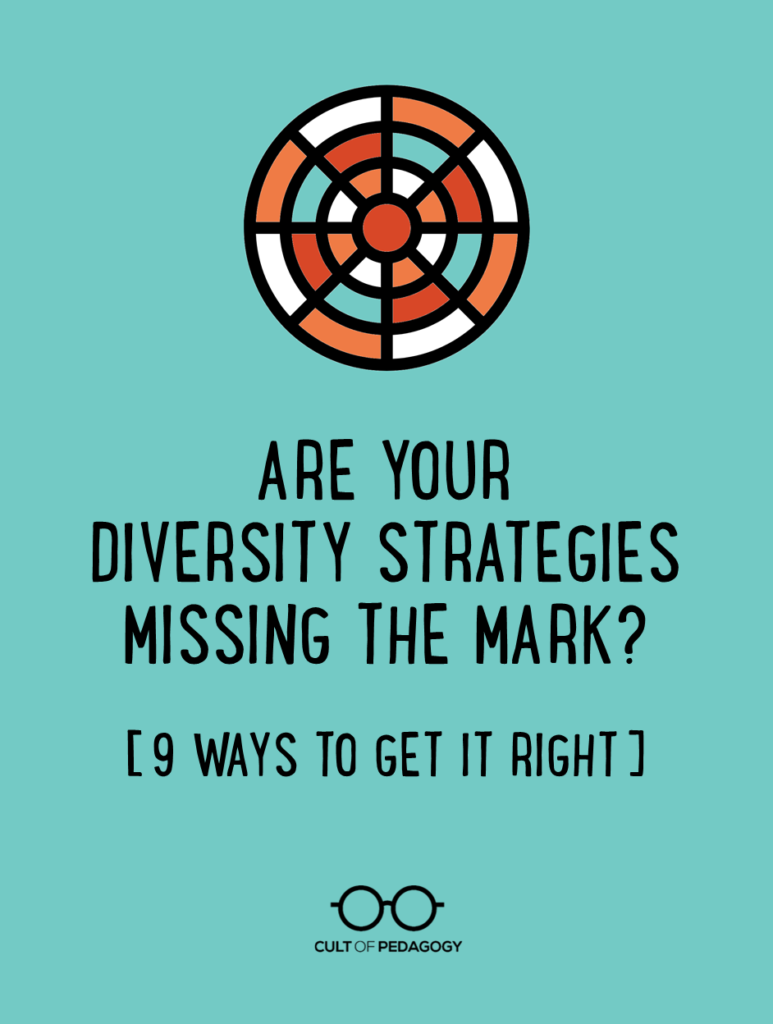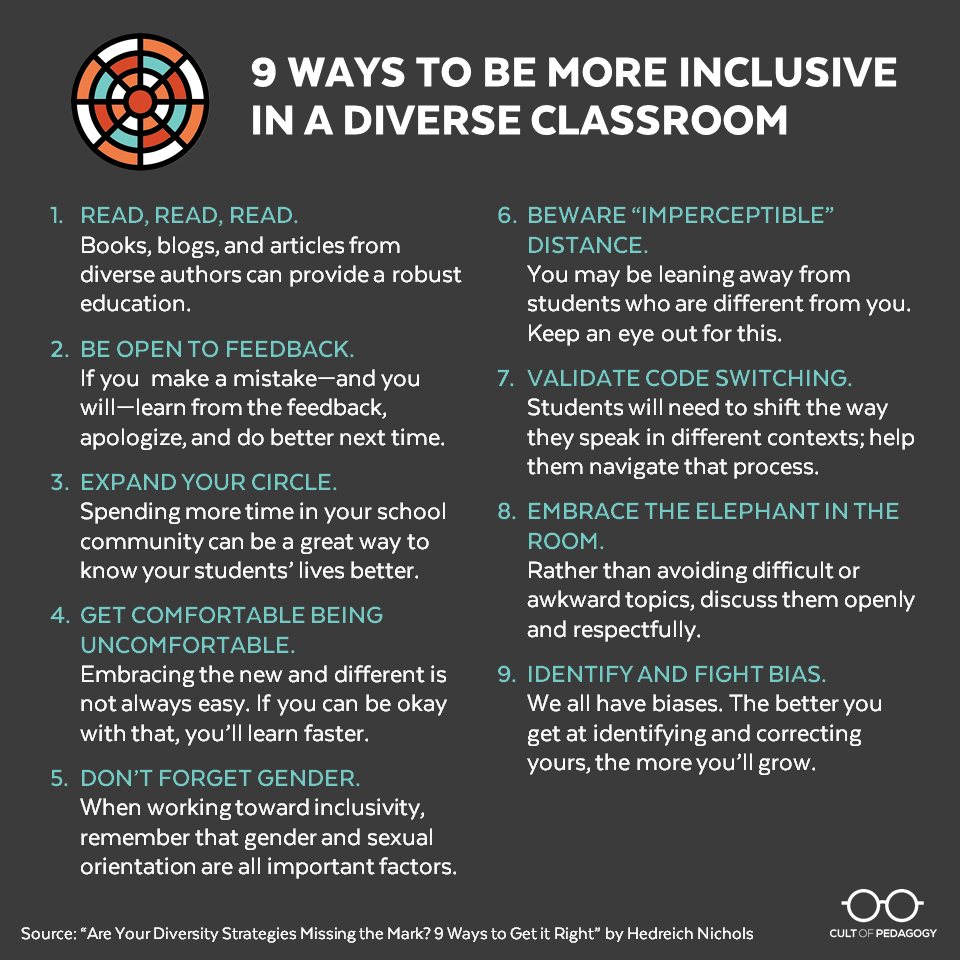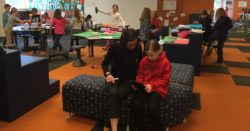
Listen to my interview with Hedreich Nichols:
Sponsored by Extempore and Participate
For most of my life, I’ve found myself in the role of the OBF, the One Black Friend in an otherwise white circle of people. While that doesn’t qualify me to be The Voice of Black Teachers and Students everywhere, my experiences have taught me a lot about what teachers can do to help students from different backgrounds feel fully included in the classroom, or in some cases, what they do to create the opposite effect.
With all our policies, culturally responsive trainings, and books on cultural diversity, we obviously have the best intentions. But are we reaching desired outcomes, or do our well-intended deeds miss the mark? I could go into statistics about disparities and point to evidence that what we are doing isn’t working, but sometimes personal experiences mean more than data. In our hearts, many of us know we are not reaching every student, so I offer this challenge: Is it possible to improve the way you relate to students from diverse backgrounds?
The OBF (or its equivalent for other ethnicities) exists in many classrooms, classrooms where teachers are trying their best to do the right thing for every student. My hope is that my stories and the easy-to-implement strategies I share here will help you improve your practice and avoid some of the faux pas that come with teaching students who may look, think, or opine differently than we do.
Life Through the Eyes of the OBF
My first OBF experience was with my first grade teacher, a gray-haired, gray-eyed “grandma” who looked different than the grandmas I knew. I remember feeling that she didn’t like me much but loved the little girl who used to steal my pencils. I knew that the girl who stole my pencils got hugs from the teacher while I got plain pencils to use instead of my fancy ones. I knew it wasn’t fair, but it taught me about the value of blonde hair and blue eyes and the lack of perceived value in my brown ones.
As an adult, I moved to Switzerland and my OBF journey continued, first as a teacher, then a mom. Free of American race politics, I learned how to fully enjoy being an OBF with only occasional blips; then I realized that not having “races” or race politics made the Swiss blissfully unaware of the plight of “others.” I began to see the hardships of refugees, people with learning or physical disabilities, and even people who were just plain different.
My blissful race-free bubble dissipated with finality the day my 5-year-old son came home with his pants pulled low, excitedly telling me of his neighborhood nickname, Gangsta. Around this same time he came home with a Black-faced, grass-skirted neger for the letter “N” on a worksheet.
It was then that I realized the depth of the “colorblindness” of Swiss society. The fact that there were no colors to see meant that most Swiss had little or no experience “seeing” any other cultures, and when race did come up, the few Brazilians, Tamils, Tibetans and Black and white refugees there were met with a wall of us vs. them as impermeable as the Alps. Without my bubble, the absence of race and race politics were no longer freeing but suddenly a personal affront that led me back home.
After repatriating, I found myself teaching music in a small Lutheran school in Texas. The teachers were welcoming, long tenured, and the school was run by a motherly woman who understood the occasional need to take off for doctor’s appointments and sick children. I enjoyed both teaching and the after-hours socializing with my OBF status taking a backseat to the commonality we shared as Christians, teachers, women and mothers. When conversations on local news or social justice issues came up, I used my voice to present another viewpoint, one that women in middle-class white circles had not been exposed to. I felt heard.
Then the 2016 election cycle hit and that was that. Things became uncomfortable. Being Black, divorced, and raising a son alone made me an “other” even in a circle of female believers. We all retreated and gave up on the community. I’m not proud of that, but at the time, I felt too alone and misunderstood to fight to sustain the relationships.
These experiences and others in my OBF journey have framed my teaching practice and provided me with tools to help me better relate to students with various backgrounds and perspectives. I call it my journey because it implies growth rather than an end goal, and the strategies below can help you in your own journey. By making small, intentional changes in the way we relate to the world around us, we can all improve our practice.
9 Ways to Create a More Inclusive Classroom
1. Read, read, read.
There is no shortage of resources, of literature from diverse authors, blogs from minority educators, articles on inclusion from educational magazines as well as scholarly articles from professors and experts. Additionally there are groups that you can join and hashtags you can follow to keep up with actual educators who are working to serve diverse students better.
While you’re reading, check your own classroom and school libraries. Book collections should reflect authors from diverse backgrounds and even our youngest students should see picture books with all kinds of people in them. Some of my favorites are Kwame Alexander, Viet Nhan Thien, Sandra Cisneros, Sarah McBride, Samira Ahmed or Poet Laureates Joy Harjo and Maya Angelou
2. Be open to feedback.
I sent a note on that worksheet mentioned above to my son’s teacher explaining that there were many N words, and expressed my willingness to help find culturally diverse resources. Her answer? “OK.” No expression of regret, no acknowledgement that she needed to do better.
Not knowing is not a criminal offense. Knowing that you don’t know and not caring, however, is deeply offensive. If you don’t know, ask. If you don’t have someone to ask, expand your circle. You’ll make mistakes, but if you’re sincerely trying to be a better practitioner, people will see that and be generous.
If you do make a mistake—and you will—apologize, learn from it, and do better next time. Just let there be a next time and don’t let getting it wrong keep you from learning, growing and trying to build better relationships with all of your students.
3. Expand your circle.
Are you in diverse enough company that someone would tell you when you get it wrong? If not, get involved in the community you teach in. This doesn’t mean you have to add more things to your to-do list or take time away from your family. Take them with you to see a student’s peewee football game, a church musical or a Juneteenth parade in your school’s community. Go shopping there. Pick up dinner from the little restaurant near your school. Find a mentor or make a friend who can help you build bridges to the community you serve. Yes, you will probably be the only white lady at the Black Baptist church and yes you will feel uncomfortable at first, but you will be welcomed. And being the one white face in a sea of brown ones will give you a deeper sense of empathy for your minority students.
When I began teaching in Switzerland, I went to every local event I could. I wanted to know the kids I taught and that meant understanding Swiss culture. It helped me to build deeper relationships and those relationships made me a better teacher. If you really can’t manage to get out into the community, start by finding out what your kids did on the weekend. That will provide clues to community life and maybe you’ll get an invitation you can’t resist.
4. Get comfortable being uncomfortable.
You will teach students who look differently, think differently or represent and believe in different things. You may at times feel challenged, out of step with cultural or modern modes of behavior. You may teach students who represent something you don’t believe in. You have to be okay with that and that’s not always easy.
My Lutheran school experience resembles challenges that arise in classrooms daily. It’s easier to simply relate to the students who are like us and, by default, leave the ones perceived as different, or difficult, by the wayside. It is often unintentional, but always unacceptable. Why should it matter that a child represents different political beliefs, wears a hijab, identifies as non-binary, is another color, or wears “weird” hair? It shouldn’t, but it usually does. It’s human nature to seek the familiar, so it’s understandable that “others” can represent a threat, a challenge to the status quo in some form. But the ability to embrace and enjoy what you think of as new and different is a sign of personal growth and maturity, and who doesn’t want that?
Embracing the new and different may come harder if you’ve been teaching a while and you feel like the goalposts keep moving. That’s where the uncomfortable part comes in. Everybody knows if you jump headlong in you get acclimated much quicker than if you wade in bit by bit. Jump in but instead of trying to embrace cultures and ideologies, embrace the child standing before you. Do your best for that one soul. Most of all, realize that you can embrace people who are different without changing who you are. That makes it no less uncomfortable, but it becomes much less scary, much more doable.

5. Don’t forget gender.
Teachers are overwhelmingly female. Middle aged, white and female. Our classes are more likely to look like Pottery Barn than a man cave. Yet, we teach students who may feel overcome by estrogen with all the rustic swirls and pretty feminine energy. Is your classroom space an environment with which all genders can identify?
And what about gender and lifestyle diversity? Are we prepared for questions that may come up? Maybe your personal stance is that gender and sexual identity questions should not be a part of primary or middle school education, but what will you do if gender-fluid children or same-sex parents are a part of your educational circle? How will you meet the needs of children who may represent a challenge to your belief system? I don’t have the answer, but these questions are worth thinking through—see #4 for advice on how to do that.
Acceptance and empathy are human and our job is to provide a space for all students to feel welcome so they can learn. If you’re uncomfortable or unknowledgeable, authors like Bonnie Combs, Rigoberto Gonzales and William Mason can help. Written for littles, without getting into the nuts and bolts of human sexuality, these books teach about diversity and acceptance.
6. Beware “imperceptible” distance.
Sometimes the scars of our collective past come to bear on our classroom interactions. Maybe you were the nerd and you have a hard time dealing with mean girls. Maybe you were the mean girl who has a hard time dealing with nerds. I got beat up in 6th and 7th grade by the mean girls. It shaped me and now I have to work hard at seeing them in all their middle school frailty. They need me as much as the artsy, bookish kindred spirits do, so I work at building relationships with them.
Are you internally putting what you hope is imperceptible distance between you and some students you find less than likeable, or are you leaning in with them? Are you challenging yourself daily to make sure that your actions line up with your intent? Children and young people are incredibly perceptive and they can sense it if you don’t like them, so try. Go the extra mile, treat them like your favored student and let your actions say what your heart may not be able to.
7. Validate code switching.
Throughout my early and middle school years, integration became more norm than exception but I never stopped being the Black girl in a sea of mostly white faces; consequently, code switching between two different worlds was my norm.
At home I listened to Motown and Rappers Delight and sang in the Gospel choir. At school I listened to Journey and sang in Madrigal group. I excelled and was well liked. I was smart, pretty, and could sing: the trifecta for Black students in white schools. In high school I reaped my great reward for being a “credit to my race” (btw, not a compliment), where my crowning “accomplishment” was winning “Miss Soul.” I couldn’t explain then why I felt embarrassed by that award. I know now that it was created so the modest number of Black kids would have a shot at winning something other than Best Athlete or Best Performer. It was the “token” award. You got it if you were Black and whites saw you as not too much unlike the majority culture. You got it if you were a master at code switching. I felt that I was being less than my authentic self until I got to college and found out that code switching is a normal part of growing up a part of two cultures.
You may see your model student get in the car with dad who has Cardi B blasting. If your reaction is to believe that the student is not who you thought he was, think again. Just as we are different as spouses than we are as parents, people fulfill different roles in the diverse communities they belong to. There’s an outfit and a language for every setting. On the playground is where Spanglish, urban or southern slang and other regional forms of English are welcome. In the classroom standard English is required. Explain that colloquial forms of English are perfectly acceptable in informal settings but the highest paying jobs (besides ballers and artists) require standardized English. Let them know that code switching is an important soft skill and a necessary one; get them started early.
8. Embrace the elephant in the room.
Race is a complex topic and although it might seem easier to avoid, it’s healthier to have open conversations where students can learn to process thoughts and ideas on race in a caring, positive setting. Even the most brutally honest question can be reframed using affirming language. For example, “Why is your skin brown?” could be answered with “Here in America we often see white skin, but the world over most people have skin in shades of brown.” “Why do you always wear a scarf?” can be explained with, “That’s called a hijab and it’s a sign of respect in the Muslim faith.” Even requests to touch a student’s hair can be redirected by instead having conversations about how exploring different hair textures and products can be fun.
And while you don’t want to ask any student to be the Voice of His People, it is perfectly acceptable to acknowledge and discuss cultural differences. Assess in a private conversation if a student feels comfortable talking about Ramadan or Dia de los Muertos with the class, or for that matter, scouting or tuba lessons. If you filter out personal perceptions or opinions about questions that arise and answer factually and calmly, a question will just be a learning opportunity. If, however, you feel that a student question is designed to be intimidating or rude, speak to that as well. Tact and kindness sometimes need to be taught, as does empathy. If tension arises between students, teach respectful conflict resolution using sentence stems.The Big Idea is to create a kinder, accepting society and that can be your guide.
9. Identify and fight bias.
If imperceptible distance is bad, tangible tension is worse. If you are a white teacher teaching minority students, you might feel challenged by a student in a way that feels disrespectful. A racially conflicted history may color the interaction. First, remember that your interaction may have nothing to do with cultural dissonance. Dealing with “attitude” is a part of the job at some point for every teacher, color and culture notwithstanding. Sometimes, however, mistrust and fear need to be overcome on both sides. That can make an interaction feel bigger than it really is and that truth alone can help temper your reactions.
If you really feel there is a racial or cultural disconnect, you might ask a trusted teacher who shares the student’s culture or one who has a better rapport with the student to have a meeting with you both. Having a second teacher monitor conflict resolution is helpful even when the issues are not cultural. Finally, if you find that you are having regular conflicts with students who share a similar background, you may want to do some soul searching. Having bias is human. Being biased against certain groups is damaging, to you as a practitioner and to the students you serve.
If you suspect your bias may be keeping your students from feeling truly comfortable in the classroom, I hope you’ve found strategies here to help. Additionally, both Learning for Justice and Harvard’s Project Implicit are great places to gain insight and find resources to help you make a change.
Throughout my journey as an OBF, I’m sure my teachers intended to encourage and empower me, and they often did. But they also told me in hundreds of little and big ways that I was an anomaly and part of a group that was sub-standard. Their well-intended strategies missed the mark. Tomorrow, I hope when you look at your students, you’ll remember my one Black friend stories and be able to identify the OBFs—and the equivalent for other ethnicities—in your class. I hope seeing them helps you feel brave, empowered and ready to build stronger relationships. I hope your intentions lead to desired outcomes and that you are able to side-step pitfalls more easily. Most of all, I hope you’ve learned something that leads you to celebrate all students, starting with the one in front of you at any given moment.
Join our mailing list and get weekly tips, tools, and inspiration that will make your teaching more effective and fun. You’ll get access to our members-only library of free downloads, including 20 Ways to Cut Your Grading Time in Half, the e-booklet that has helped thousands of teachers save time on grading. Over 50,000 teachers have already joined—come on in.





Thanks for sharing this podcast. It was amazing and I will be incorporating it in our March Faculty meeting!!
Glad you found this helpful, Sam! Thanks for letting us know.
Thank you for sharing this. Our district is currently engaged in accelerating empowerment and equity throughout our schools. We have a committee that is working to increase opportunities, access and success for all students. It is a big undertaking but we recognize the importance of the vision.
Thank you so much! I was wrong to expect a stilled bias from you before even reading what you wrote. Thank you so much for sharing your very varied background in a meaningful and encouraging way. I had the privilege of being a European kid who grew up in the jungles of South East Asia. I had the privilege of caring parents who taught us that we were no better than those around us, and that service to God and man was the greatest good, as long as we were humble. I have had the privilege of coming to America and joining this 250 year experiment. Most importantly, I interact daily with high school students in a very diverse high school in Southern California. I am able to learn from them listen to them, encourage them to use their voice and let them know that they are valuable, unique, and special.
Dear Jen and Hedreich,
Thank you for a fun, insightful, and thoughtful podcast on such an important topic. Every single point that you shared is applicable to supporting language learners, many of which I never thought about.
There are a few additional ones that teachers working with language learners might consider to create a welcoming environment that was not addressed in the podcast such as:
– calling students by their names
– using texts that reflect students’ experiences and cultures
– translanguaging: allowing students to use their home languages at school
– expecting language learners to engage in the same activities and learn the same content as everyone else
I wrote about it more extensively on this blog post (https://www.empoweringells.com/welcoming-environment/).
Thank you for taking the time to share your wisdom and your personal experience. It made the podcast real and fun, especially the stories you shared about your son! He is lucky to cared for by you!
I have listened to this podcast three times this week. Recently my alma mater has been in the news for not being inclusive. Among other things, they had an incident where students made really racist anonymous comments in a really public way.
I’m embarrassed and heartsick.
It has caused me to do a lot of introspection. How can I teach myself, my children and my students to do better? I hear these same things from my own students almost every day. How do I address it? I wish I had a list of what not to say. This episode was such a blessing. Thank you. I would like to hear more.
Thank you for writing this and enlightening people. I think these are great ways to help create a healthy caring environment at school. I will try to implement these at CVESD!
I so appreciate this post for a number of reasons. These are concrete and attainable goals that any instructor can infuse into their practice in order to intentionally reduce/remove bias from their classroom and their teaching. I connected particularly with the concept of imperceptible difference as the more we reflect upon our own actions and our own biases, this is excellent modelling for our students, but also we make significant improvements for ourselves and our classrooms.
Thank you for providing practical tips and suggestions. In my school district I am responsible for facilitating professional learning. This year my focus is culturally-responsive teaching. I can easily incorporate this information into my presentations. Thank you again!
Lacrecia–YAY! So glad that you found this helpful! Let us know if you need help finding any other resources on the site.